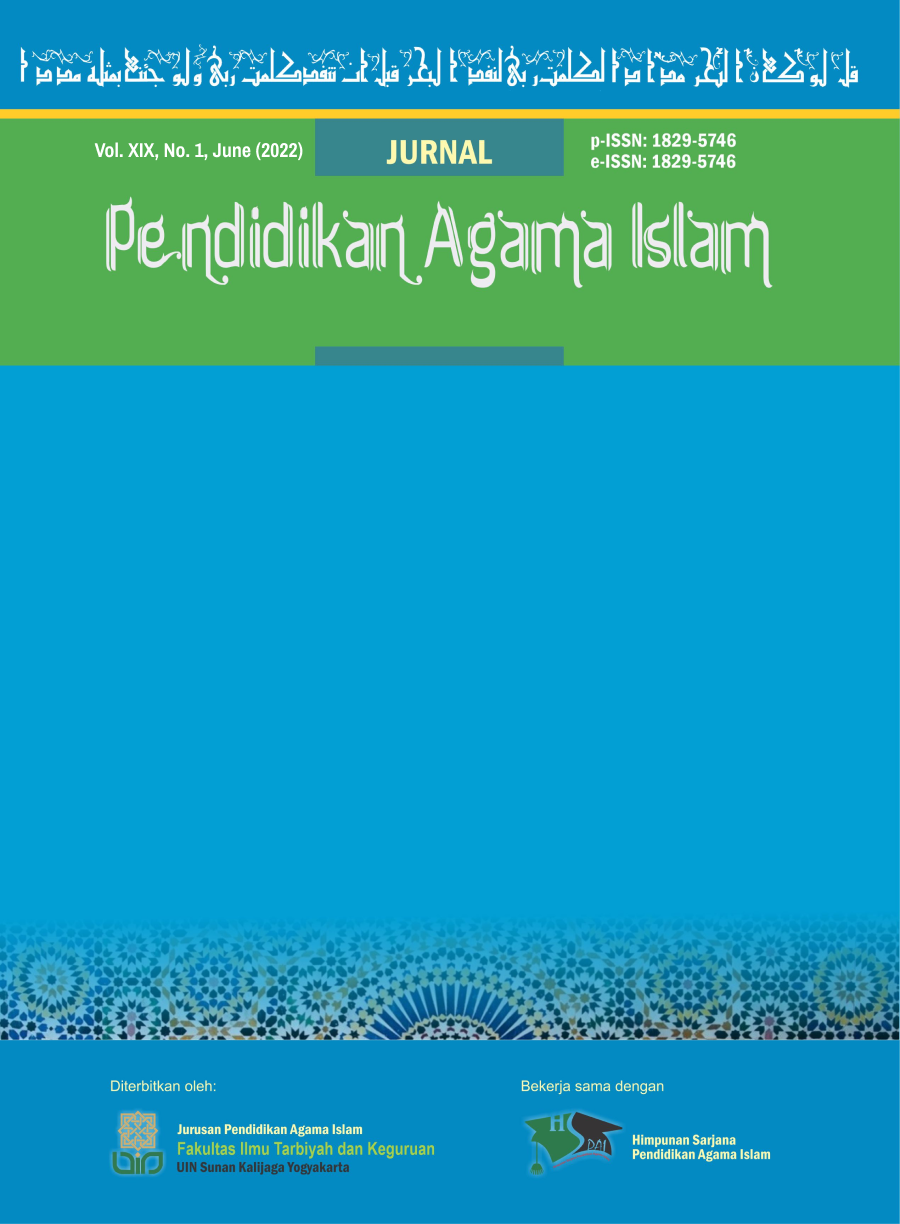The Comparison of Religiosity Level Between Students With “Niqab” and Students Without “Niqab”
##plugins.themes.bootstrap3.article.main##
Abstract
Purpose – This study intends to examine whether there is a difference in the level of religiosity between students with “niqab” and students without “niqab”. The discourse on wearing the “niqab”l is still a crucial problem in several educational institutions in Indonesia, including Universitas Ahmad Dahlan (UAD).
Design/methods/approach – This is quantitative research at the Ahmad Dahlan University Islamic Education Study Program with a random sampling technique. The data collection tool used was a questionnaire with a Likert scale of scale 4. The instrument was tested with validity, reliability, normality, and homogeneity tests. The data were then analyzed by using the T-test to test the hypothesis.
Findings – The results showed that the level of religiosity of female students with “niqab” at Pendidikan Agama Islam (PAI) UAD was in the high category. This was evidenced by 33 respondents of students with “niqab” at PAI UAD. 23 subjects (69.6%) showed a high religiosity and ten subjects (30.3%) were in the medium category. The religiosity of students without “niqab” at PAI UAD was also in the high category, as shown by 33 respondents who are without “niqab” at PAI UAD. There were 26 subjects (78.7%) showing a high level of religiosity, and seven subjects (21.2%)were in the medium category.
Research implications/limitations – The analysis results showed that there was no difference in the level of religiosity between students with “niqab’ and students without “niqab” at PAI UAD, as evidenced by the t count = 0.452 (sig < 0.05) then Ha was accepted, and Ho was rejected.
Originality/value – There is no difference in the level of religiosity between students with “niqab” and students without “niqab” in PAI UAD. “Niqab” is not part of Islamic shari'a so it cannot always be associated with one's religious experience. The nature of religiosity cannot be established simply by wearing the “niqab” without looking at other religious dimensions.
Keywords:
Downloads
##plugins.themes.bootstrap3.article.details##
Copyright

This work is licensed under a Creative Commons Attribution-ShareAlike 4.0 International License.
Copyright Notice
Authors who publish with this journal agree to the following terms:
- Authors retain copyright and grant the journal right of first publication with the work simultaneously licensed under a Creative Commons Attribution License that allows others to share the work with an acknowledgement of the work's authorship and initial publication in this journal.
- Authors are able to enter into separate, additional contractual arrangements for the non-exclusive distribution of the journal's published version of the work (e.g., post it to an institutional repository or publish it in a book), with an acknowledgement of its initial publication in this journal.
- Authors are permitted and encouraged to post their work online (e.g., in institutional repositories or on their website) prior to and during the submission process, as it can lead to productive exchanges, as well as earlier and greater citation of published work.
References
Al-Khalifah. (2004). Religiosity in Islam as A Protective Mechanism Againt Criminal Tempation. The American Journal of Islamic Social Sciences, 11, 1–12.
Arikunto, S. (2010). Prosedur Penelitian Suatu Pendekatan Praktik. Rineka Cipta.
Creswell, J. W. (2013). Research Design Pendekatan Kualitatif, Kuantitatif dan Mixed. Pustaka Pelajar.
Dewi, P. A. R. (2019). Niqab Sebagai Fashion: Dialektik Konservatisme Dan Budaya Populer. Scriptura, 9(1), 9–15. https://doi.org/10.9744/scriptura.9.1.9-15
Djamaludin, A. dan F. N. S. (2011). Psikologi Islam: Solusi Islam Atas Problem-Problem Psikologi. Pustaka Pelajar.
Ekawati, R. (2018). Cadar Dalam Perspektif Syariah dan Budaya. Universitas Alaudin Makassar.
Eko Herianto. (2017). Metodologi Penelitian. Rineka Cipta.
Ghozali, I. (2014). Aplikasi Analisis Multivariete Dengan Program IBM SPSS 23 (Edisi 8). Universitas Diponegorto.
Hadi, S. (2020). Metodologi Research. Andi Ofset.
Hardani Ustiawaty, J. A. H. (2017). Buku Metode Penelitian Kualitatif dan Kuantitatif (Issue April).
Ishomuddin. (2012). Pengantar Sosiologi Agama. Ghalia Indonesia.
Jalaludin Rahmat. (2011). Psikologi Agama. Rajawali Pers.
Jalaludin Rahmat. (2013). Psikologi Agama. Raja Grafindo Persada.
Jardim, G. L., & Vorster, J. M. (2013). Hijab dan the construction of female religious identity. Indie Skriflig, 36(2), 271–287. https://doi.org/10.4102ids.v37i2.469
Moeloeng, L. (2007). Metodologi Penelitian Kualitatif. Remaja Rosdakarya.
Mujahidin, M. (2019). Cadar: Antara Ajaran Agama dan Budaya. JUSPI (Jurnal Sejarah Peradaban Islam), 3(1), 11. https://doi.org/10.30829/juspi.v3i1.3142
Mutiah. (2013). Dinamika komunikasi wanita Arab bercadar. Jurnal Penelitian Komunikasi, 16 (1), 55–70.
Najmi Fuady. (2019). FENOMENA CADAR ZAMAN NOW.
Nurul, I. (2018). Tindakan Sosial Dan Religuisitas Perempuan Bercadar. Universitas Airlangga.
Putra, H. (2015). Bercadar, wajib, sunah, atau mubah? Republika.
Ratri Lintang. (2011). Cadar, Media, Dan Identitas Perempuan Muslim. Forum, 39(2), 29–37.
Spilka, B., Hood, R.W., Gorsuch, R. (2013). The Psychology of Religion: An Empirical Approach. Engelwood Cliff, Prentice Hall.
Subandi. (2003). Hubungan antara Tingkat Religiusitas dengan Kecemasan pada Remaja.
Subandi, M. A. (2013). Psikologi agama & kesehatan mental. Pustaka Belajar.
Sugiyono. (2015). Statistika untuk Penelitian. Alfabeta.
Sujarweni, V. W. (2014). SPSS untuk Penelitian. Pustaka Baru.
Suyuti, M. (2014). Cadar bukan pakaian muslimah.
Tim Fatwa Majelis Tarjih dan Tajdid Pimpinan Pusat Muhammadiyah. (2009). Hukum tentang jenggot dan cadar.
Zakiah, D. (2013). Ilmu Jiwa Agama. Bulan Bintang.
498
Views
685
Downloads





